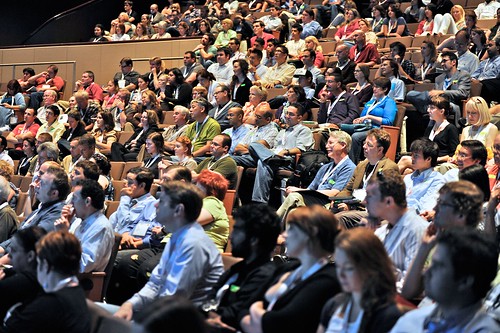TED is a nonprofit organization devoted to Ideas Worth Spreading. Starting as a four-day conference in California 25 years ago, TED has grown to support those world-changing ideas with multiple initiatives. The annual TED Conference invites the world’s leading thinkers and doers to speak for 18 minutes. Their talks are then made available, free, at TED.com. The x in TEDx denotes an independently organized event. In the spirit of ideas worth spreading, TEDx is a program of local, self-organized events that bring people together to share a TED-like experience. At a TEDx event, TEDTalks videos and live speakers combine to spark deep discussion and connection in a small group.
This past Saturday, Hannah, Emily, and Ting had the opportunity to attend Houston’s first TEDx event, held at the University of Houston’s Wortham Auditorium, devoted to Expanding Perceptions. The speakers were a diverse group of artists, designers, entrepreneurs, scholars, architects, medical professionals, and other visionaries who are creating positive change within the Houston community and around the world. In between talks, they met and conversed with all sorts of interesting people who shared a desire to obtain and synthesize ideas.
Impressions:
Hannah
To use only one word, TEDx Houston was enlightening. Between fascinating speakers and new acquaintances, I got far more out of the event than I had expected. Dr. Brené Brown’s account of her findings regarding shame and vulnerability and Dr. David Eagleman’s musings on the false dichotomy between science and religion gave me significant insights into my own life and reality, so those were the talks I could connect the most with. I was also drawn to the overriding theme of “making do with what you have,” which was approached in various ways (notably by Dan Phillips, who builds builds affordable houses from reclaimed and recycled materials).
The block of Rice speakers made me truly proud to attend this university. The heartfelt applause for Drs. Rebecca Richards-Kortum and Maria Oden as they talked about Rice’s Beyond Traditional Borders initiative and the work that is done at the Oshman Engineering Design Kitchen was touching; I hope more people realize how feasible it is to solve the world’s most pressing health problems! Also, Dr. Stephen Klineberg’s talk about the Houston Area Survey and the remarkable demographic changes that the city has undergone was very informative: among other surprising statistics, I didn’t know that Houston currently has more (and younger) Hispanic residents than Anglos. Lastly, performances by the Two Star Symphony and a couple of Houston Ballet dancers made for wonderful spectacles.
Emily
I am so happy I devoted my Saturday to the Tedx Houston event; if school could be like this—and by this I mean one speaker after the other stretching my perception of human ability and creativity—I would never leave the classroom. I was greatly impressed by the wealth of knowledge and hope these people were able to deliver to a crowd of Houstonians. Favorite speakers for me included Dan Phillips, a man from Huntsville Texas who devotes his life to building cozy houses out of found and recycled materials, Dr. David Eagleman, who redefined my understanding of the world religions and how they affect society today, and David Crossley, a man who made it his mission to improve the quality of life in Houston by rethinking how a big, sprawling city should organize its commercial spaces, residential areas, and farmland.
Like Hannah, I was proud to be a student at Rice that day. Between the enlightening lectures by Dr. Klineberg and Dr. Wolfe, and the innovative devices created by students to improve global health under the tutelage of Dr. Oden and Dr. Richards-Kortum, I learned activities of those on my own campus that I had recently not been aware. It’s amazing what a team of students can achieve. I can only hope that Hannah, Ting, Quique and I will be as successful with our EDAAC summer project.
Ting
I was amazed at the range of topics covered, from construction to music. I loved the talk given by Dan Phillips from The Phoenix Commotion. Phillips uses perfectly usable goods that people throw away to build houses for low income families, single mothers, and artists. The houses are beautiful, and a living testament to his claim that repetition creates order, so a crooked pattern will look beautiful when repeated many times. Then there was the talk by Gracie Cavnar, founder of the Recipe for Success, who really has me waiting eagerly for the 100 acre urban farm coming soon to Houston.
I was also impressed by the display of fine arts, both the memorized self-composed performances of Two Star Symphony and the contemporary ballet performances from the troupe of Dominic Walsh. It was interesting to see behind the scenes and observe how a choreographer directs the dancers in rehearsals. Of course, the Rice professors were amazing as well, especially Dr.Oden and Dr.Richard-Kortum who showed everyone that students can help the world. I hope that our work this summer will have such an impact as well. All in all, it was a Saturday well spent in expanding my own perceptions.

Find Hannah, Emily, and Ting in the audience!





 The
The 
